H. Moser & Cie Funky Blue Streamliner Flyback Chronograph: Not Just Another Pretty Blue Face
by GaryG
Balance is such a difficult thing to achieve in watch design. I’m sure we all know multiple examples of pieces that are oh-so-close to being just right, with the exception of one feature or another that is either out of proportion or too prominent given the rest of the watch’s elements.
And for whatever reason, certain combinations of dial and case colors seem to work better than others, with the ideal combinations (at least as seen by the center of gravity of enthusiast views) not universal across references but highly watch-specific.
Sure, the Vianney Halter Antiqua is made in other metals, but the pink gold version is “the one.” And there’s a reason why the Patek Philippe Reference 5070P in platinum with its blue slate dial resells for more than twice the price of the other 5070 variants.
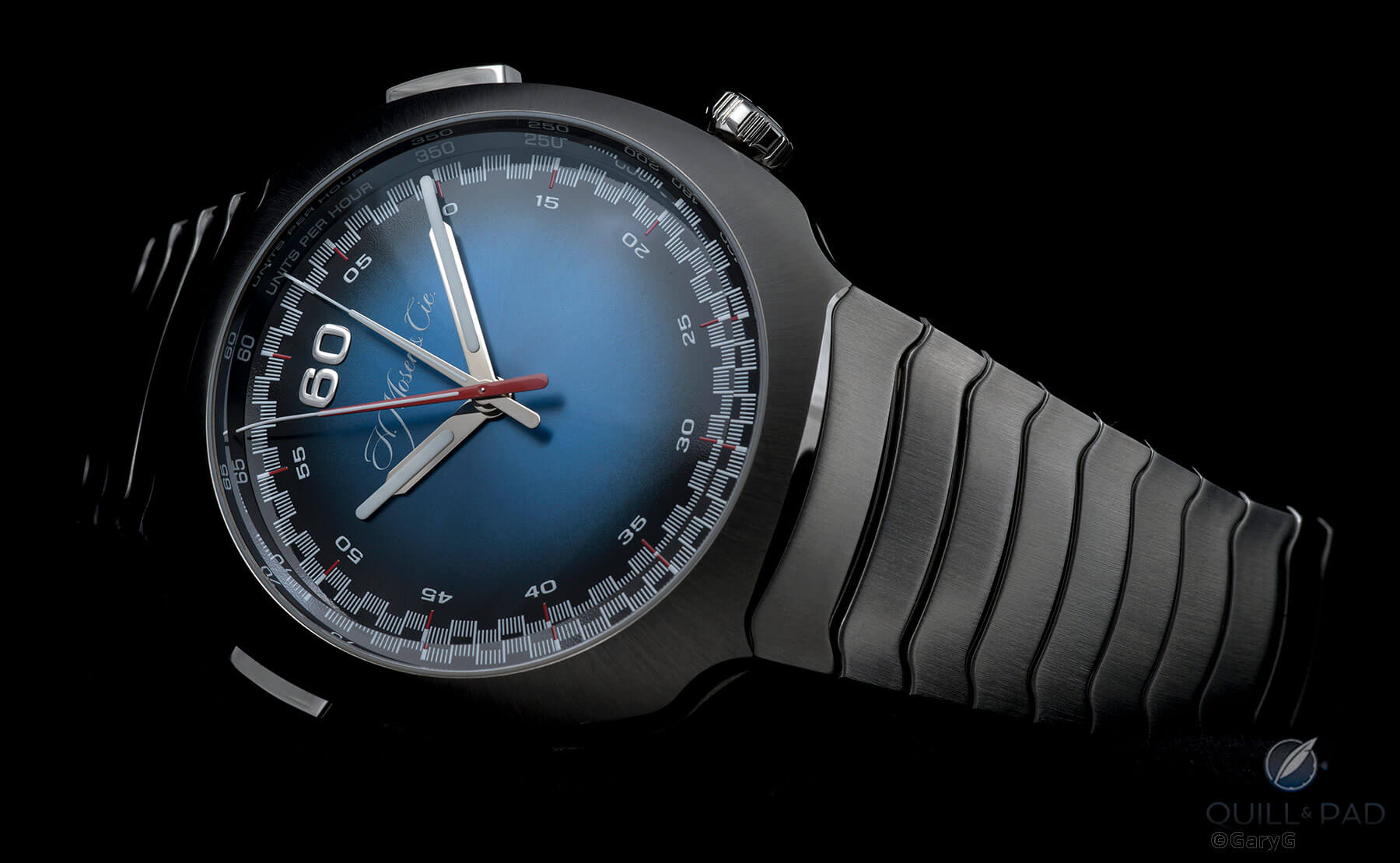
H. Moser & Cie Funky Blue Streamliner Flyback Chronograph
At least for me, so it is with the Moser Streamliner Chronograph. When I first saw an example of the limited-edition grey-dialed launch edition late last year, it seemed to me there was too little going on visually with the vertically brushed dark dial and a bit too much happening by comparison with the wavy gravy shapes of the streamlined bracelet for me to make sense of the complete watch.
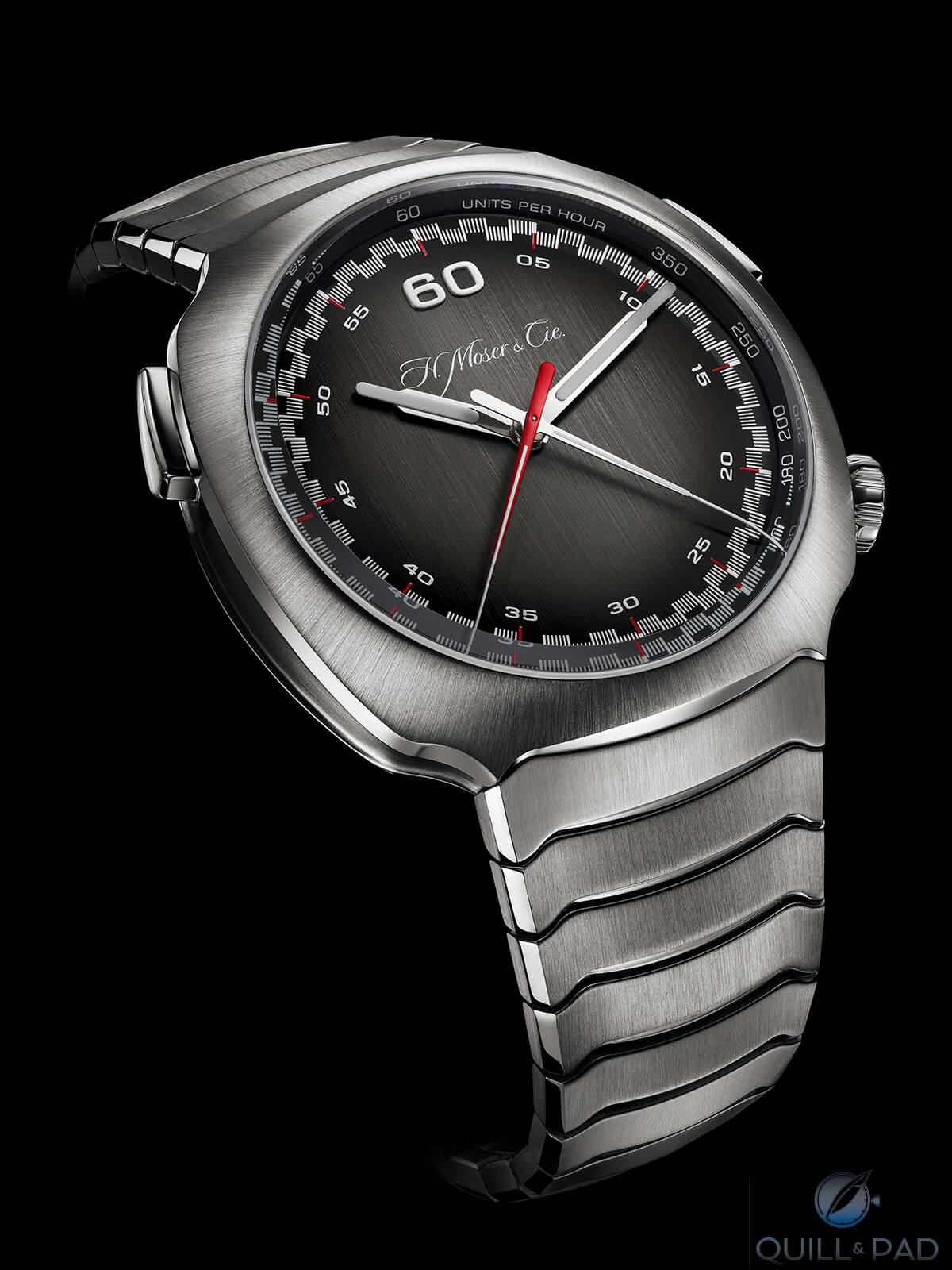
H. Moser & Cie Streamliner Flyback Chronograph Automatic
No disrespect of course to the 100 folks who bought, and no doubt, love it! It just didn’t conjure up the voices of angels for me. And I’ll confess that I wasn’t fully convinced by this year’s time-only Streamliner with its shocking green dial, either.
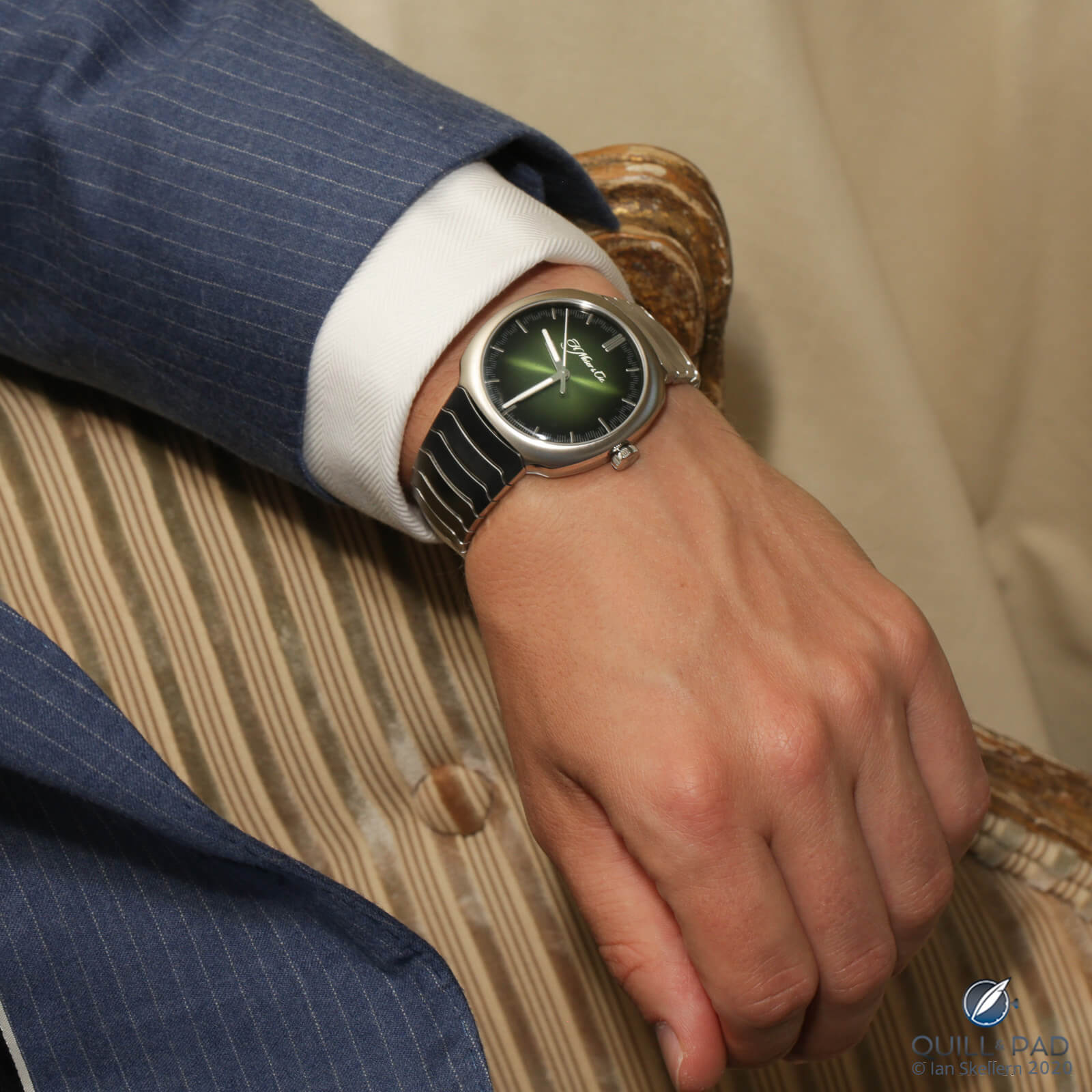
H. Moser Cie. Streamliner Centre Seconds with green dial on the wrist
Fast forward to November and the announcement of the latest Streamliner chrono, this time with a radially brushed “Funky Blue” dial.
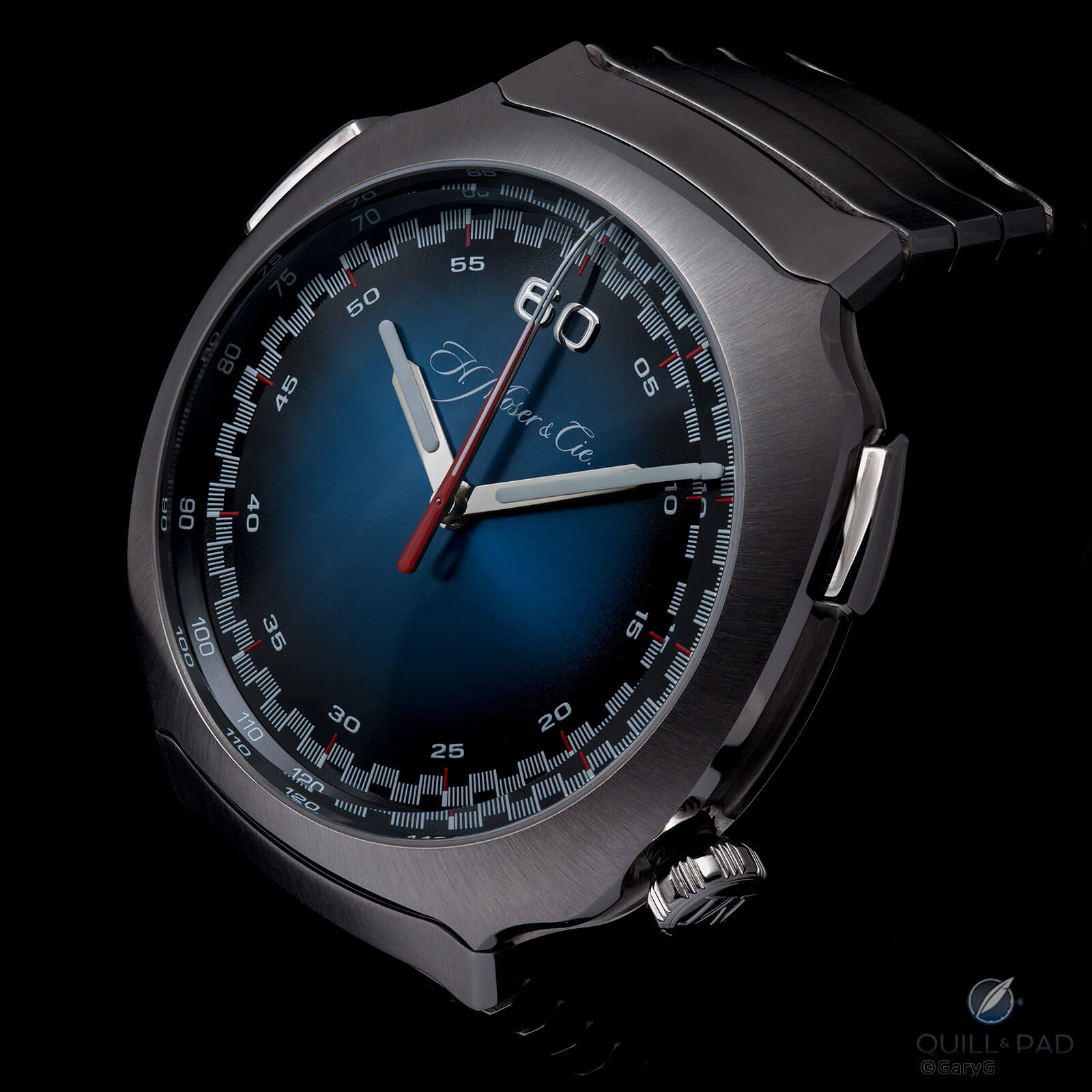
Just right: H. Moser Streamliner & Cie Flyback Funky Blue
Now this one looked to have some real promise! Like many, I’m a sucker for blue-dialed watches – at some point I’ll have to count them up and calculate the percentage of my assortment that consists of these, but it’s non-trivial – but at least from the initial photos the Funky Blue version also just seemed more balanced to my eye. So, it was with pleasure that I took on the opportunity to check out and photograph this latest edition.
What I like about the H. Moser & Cie Funky Blue Streamliner Flyback Chronograph
Not surprisingly, I’ll start with the blue fumé dial, in the recognizable Moser house style. Perhaps even more than on other Moser watches I’ve handled, this particular dial changes appearance quite a bit depending on position and lighting: in the photo above, for instance, the radial shift from blue to black is quite evident.
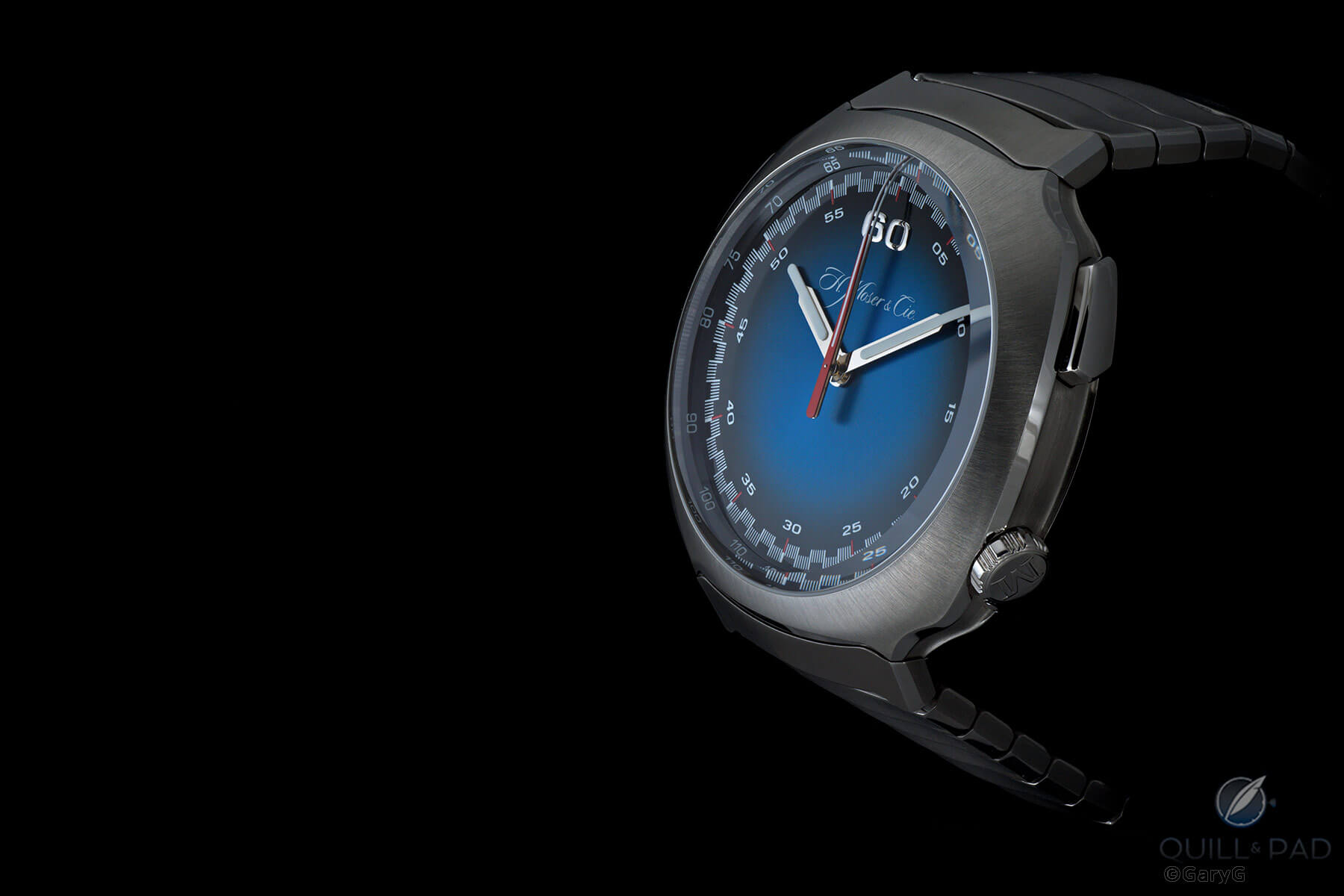
Funky indeed: fumé dial, H. Moser & Cie Streamliner
With the visual pop provided by the blue center, the remaining visual elements on the dial side go from not quite enough to just right for my preference for a bit of clutter on a watch dial. Again, this is very much a matter of personal taste: when I shared a couple of initial photos of the Streamliner with friends, a couple of them commented unfavorably on the seconds track with its offset for each succeeding second, which I think is actually fairly inspired.
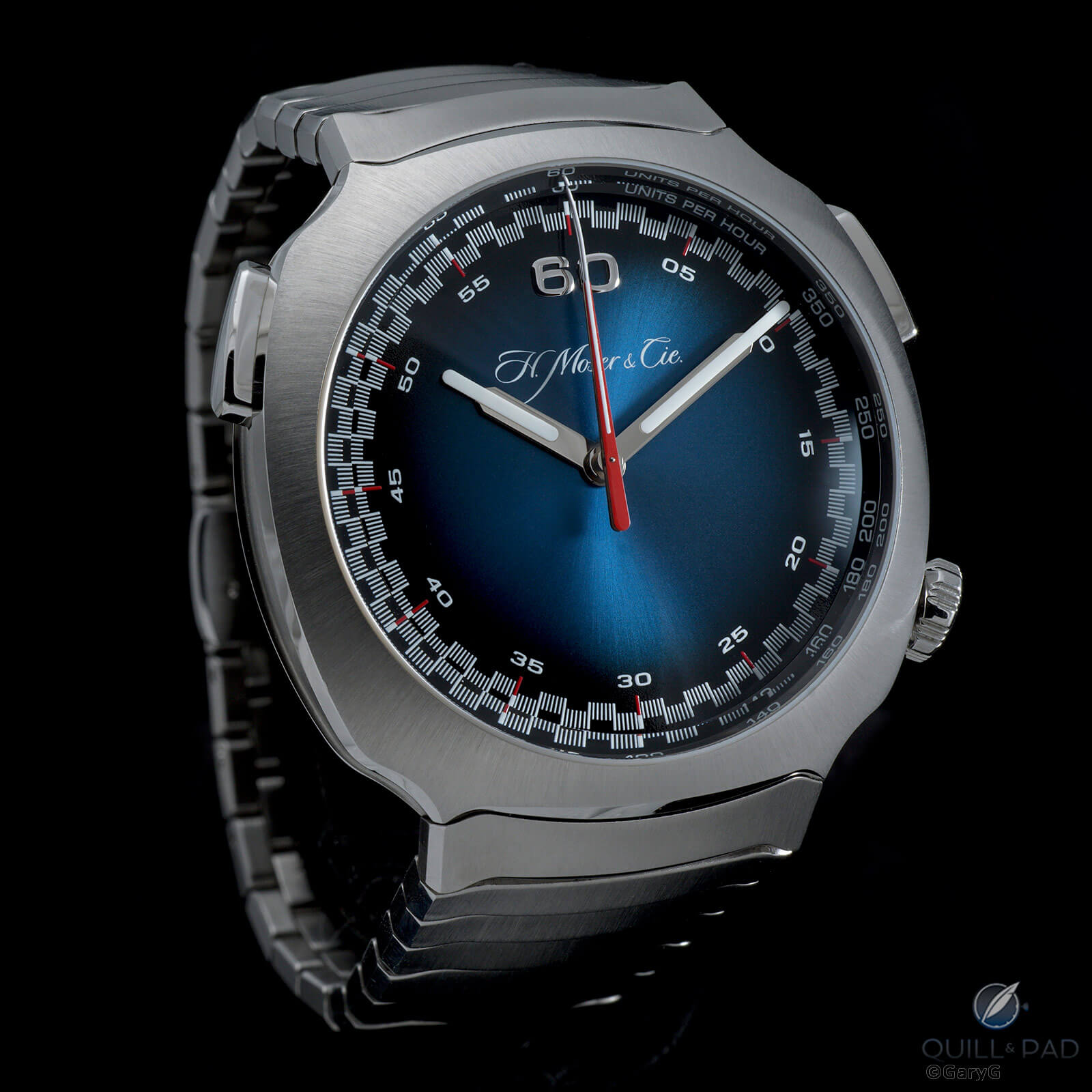
H. Moser & Cie Streamliner Flyback Chronograph with offset seconds track
The other design choices on the dial, including the omission of hour markers (which in my view would have been too much when piled atop the seconds numerals and peripheral tachymeter), the jolt of color from the red chronograph second hand, and even the oversized applied “60,” come together in this version in a way that is intriguing rather than jarring, especially when seen on the wrist.
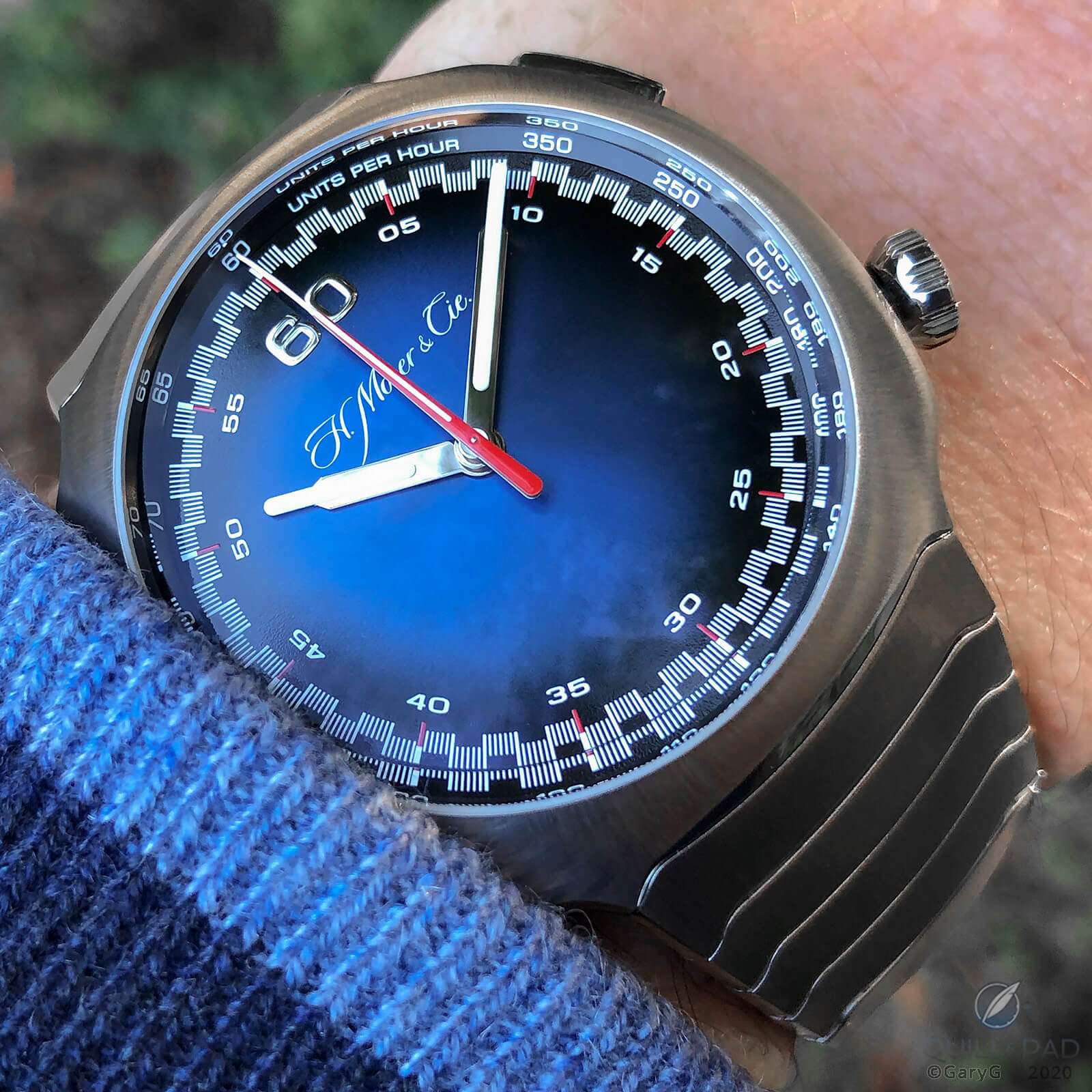
On the wrist: H. Moser & Cie Streamliner Flyback Chronograph Funky Blue
Finally, when compared with Singer and Fabergé watches based on Agenhor’s inspired AgenGraphe movement, Moser’s choice of central hour and minute hands rather than a peripheral time display and the elimination of an hour counter for the chronograph creates an entirely different, and for me, pleasing, result.
And how about that movement! We’ve talked extensively here at Quill & Pad about the wonders of the AgenGraphe, its central chronograph module, and the automatic winding rotor cleverly hidden on the dial side of the movement, so I won’t go on at length about it again here.
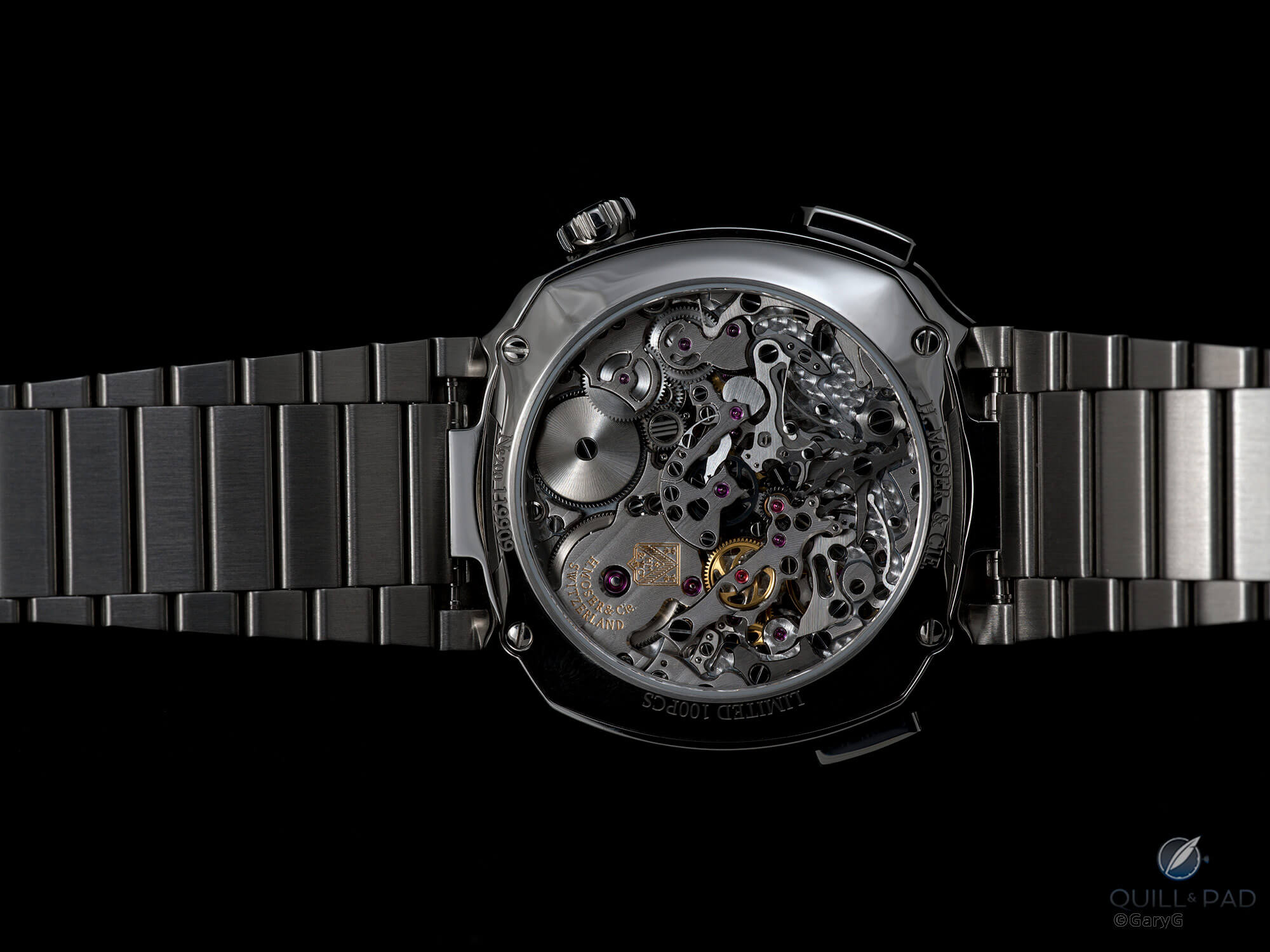
H. Moser & Cie Caliber HMC 902 chronograph movement
What is notable this time around is that in addition to the simplification and reorientation of the dial-side time and chronograph displays, in the Streamliner Moser and Agenhor have added a flyback function to the chrono, which significantly ups the ante in my view.
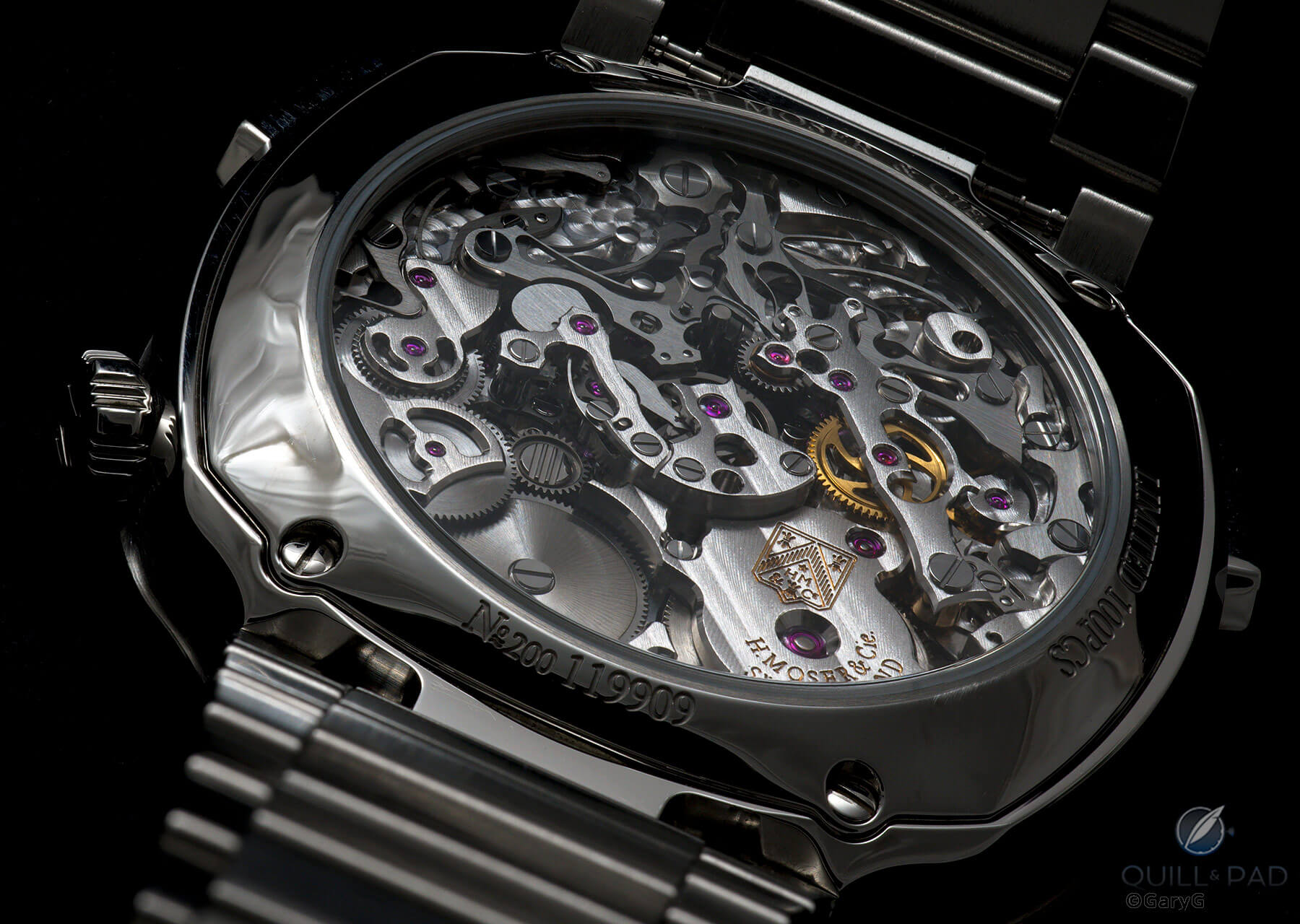
And it flies back: HMC 902 chronograph movement
In operation, the chronograph start-stop button is positive without being stiff or clunky, and the chronograph second hand moves off smoothly with virtually no jumping or jittering. At each minute, the instantaneous chronograph minute hand jumps with absolute clarity, made even more fun by the distance it travels due to its central axis positioning. And the flyback/return to zero is perhaps the best-feeling bit of all, giving a smoothly progressive tactile experience.
I also like the almost liquid look of the steel bezel surrounding the movement; and while you’re admiring that feature in the photo below, take a closer look to pick out the whimsical Batman element incorporated into the movement.
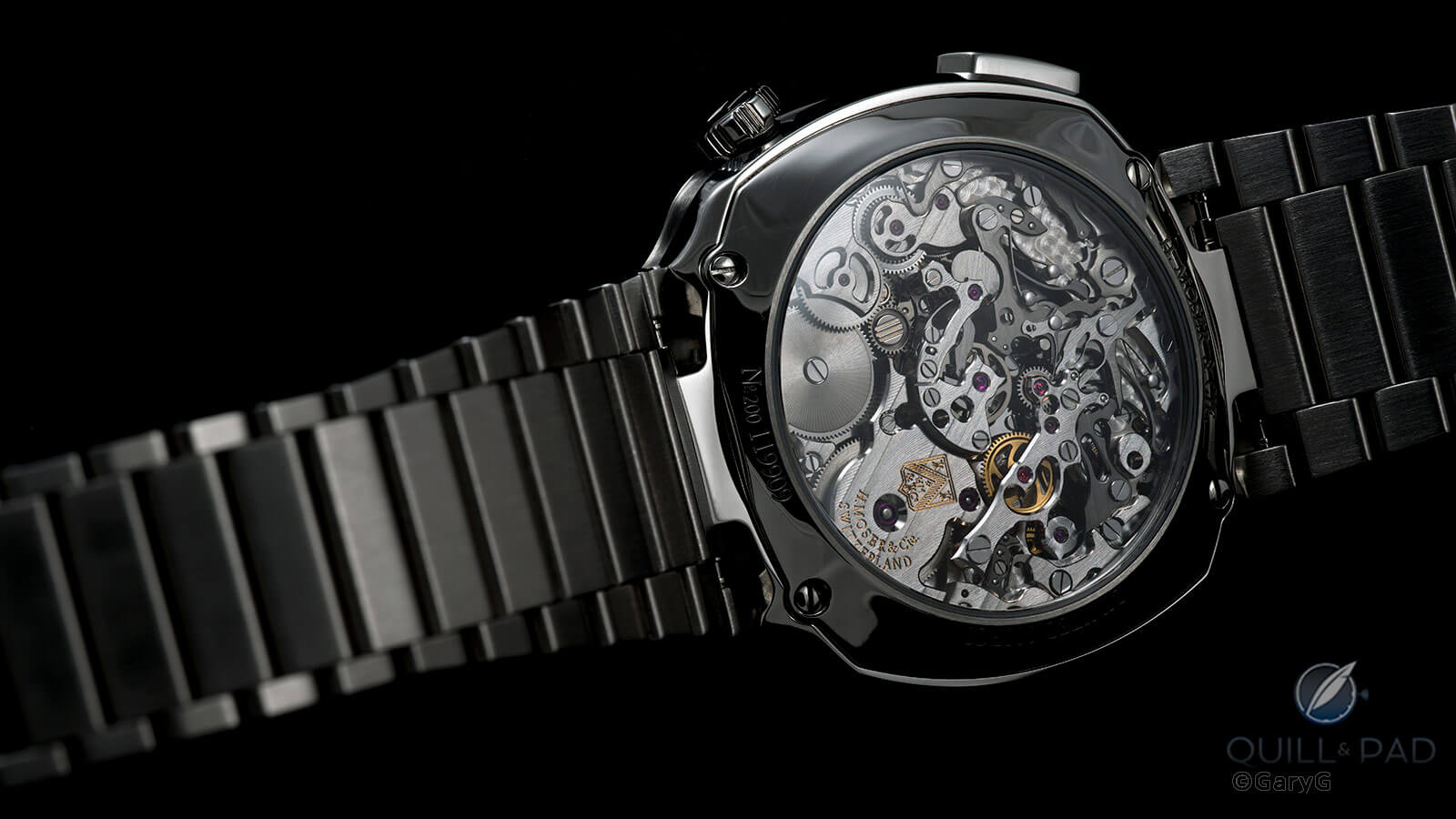
I am the Batman: movement side, H. Moser Streamliner Flyback Chronograph
The rest of the case design also impresses. I found that while the watch looks a bit chunky off the wrist, the lugless design allows it to sit nicely on the wrist. And the arched bezel contours and matched pusher shapes create a seamless, flowing impression that fully delivers on the Streamliner name.
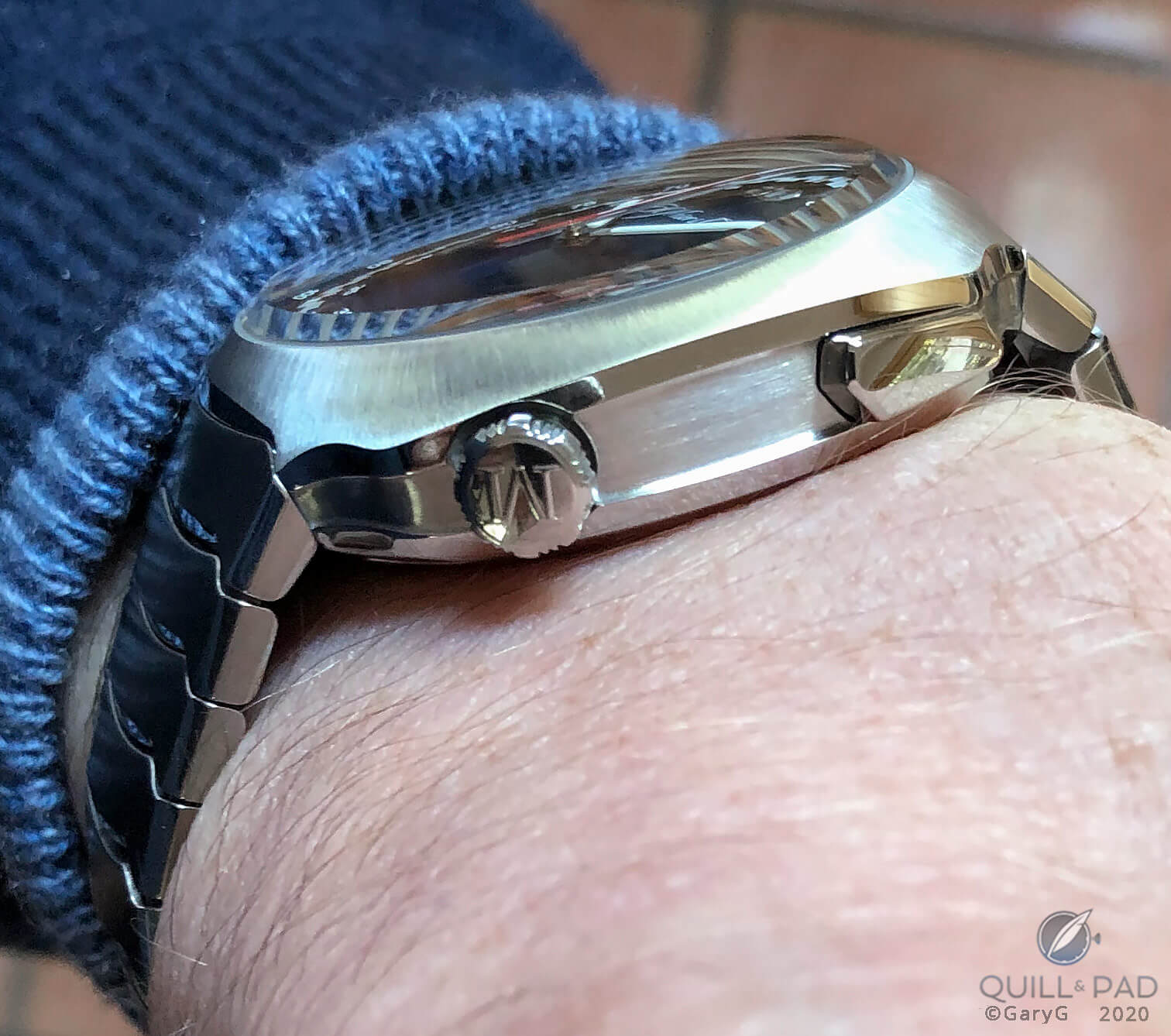
Contour view on the wrist, H. Moser & Cie Streamliner Flyback
Finally, the radial brushing of the severely sloped front bezel helps to integrate it into the bracelet below, softens the visual impact of the large steel surface, mirrors the brushing of the dial, and takes the potential scratch magnet index of the watch down quite a bit.
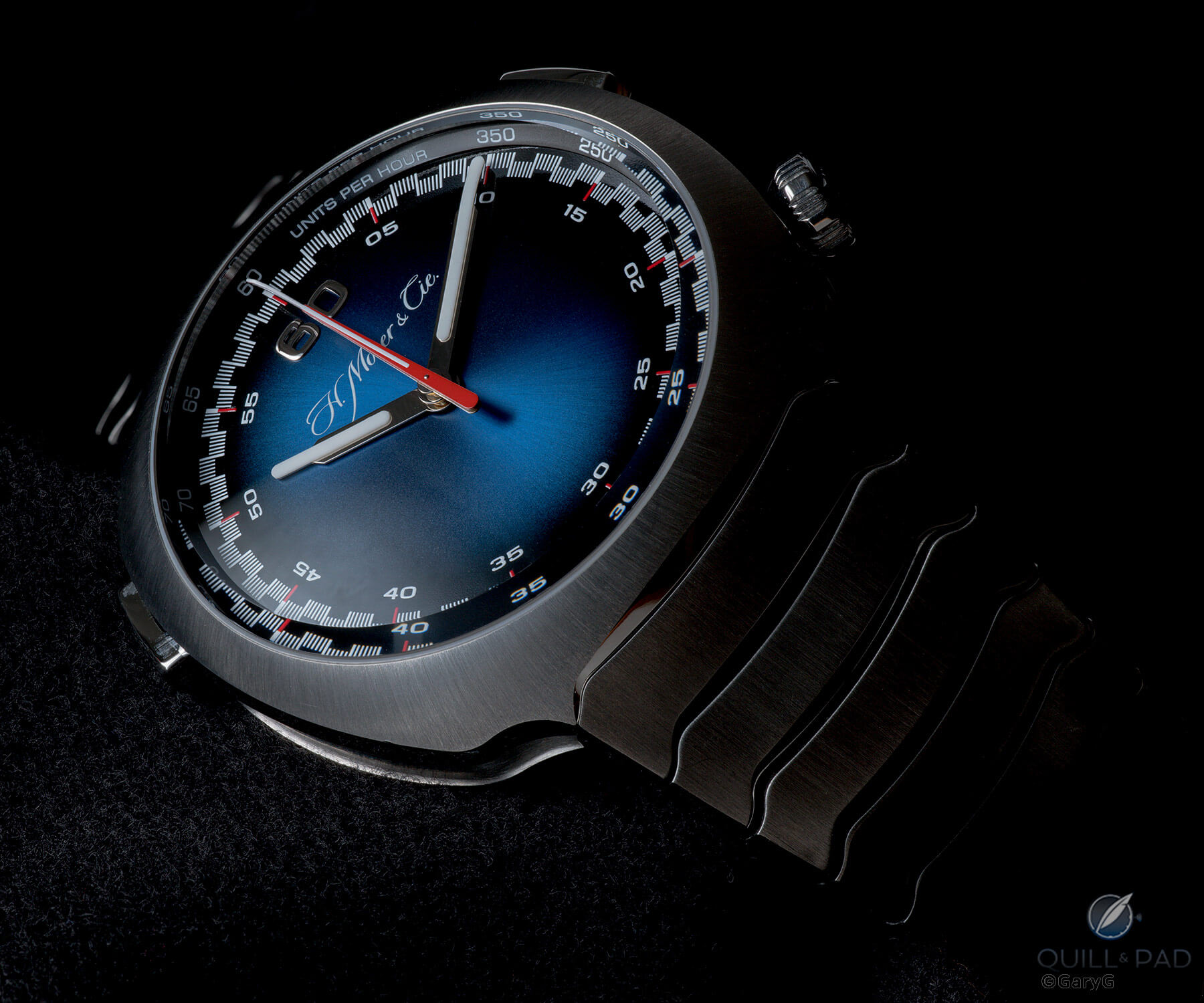
Harmonious design: radially brushed dial and bezel, H. Moser & Cie Streamliner
What about the bracelet?
It says it right on the Moser website: the Streamliner series was “originally designed from the integrated steel bracelet up.” Whether you see fish scales, a lobster shell, a 1920s locomotive design, or some touches of earlier Ebel or Porsche Design watches, the integrated bracelet is to a large extent what makes this a true exercise in streamlined design.
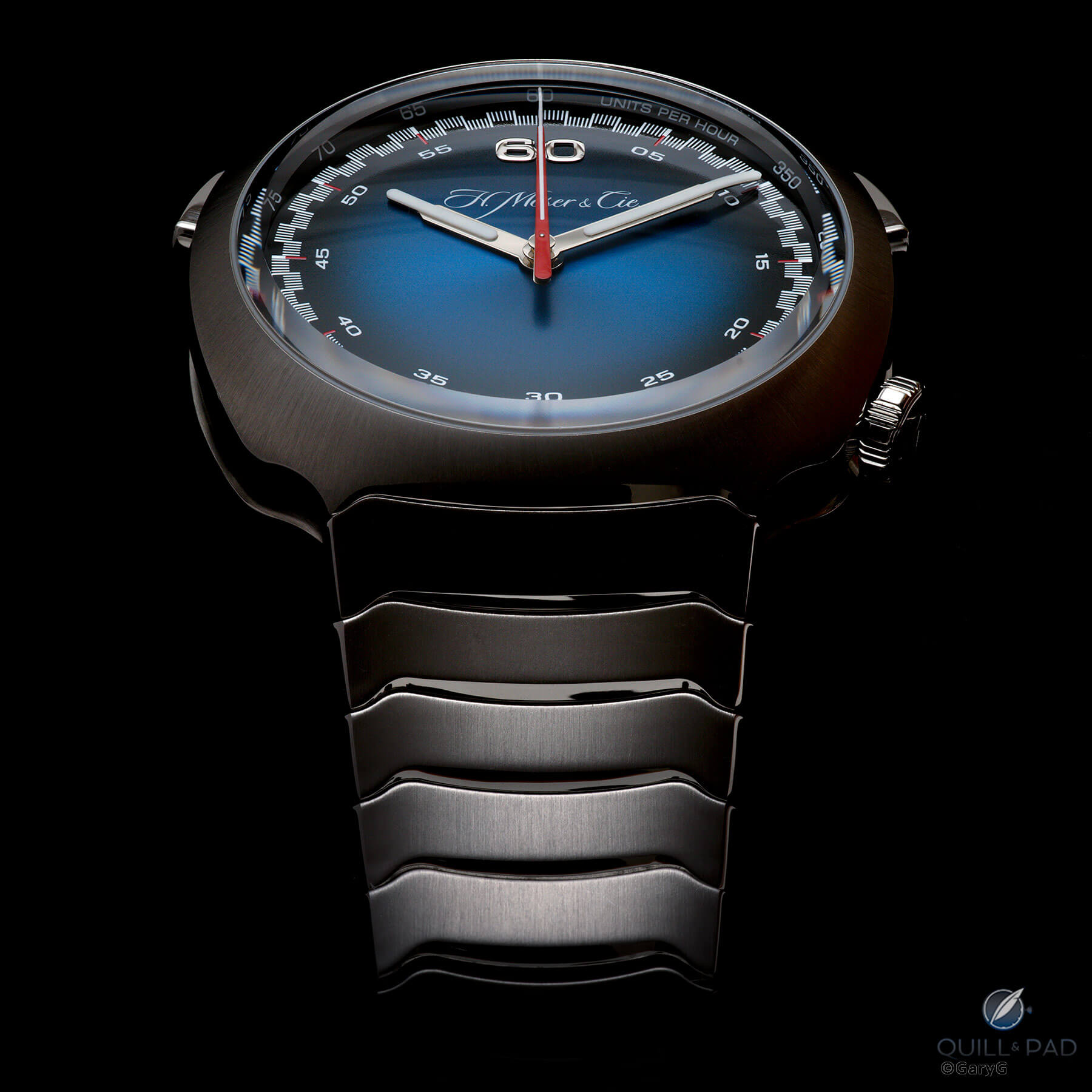
Coherent design: H. Moser & Cie Streamliner with its integrated bracelet
I don’t think there’s any doubt that the bracelet and case are a wonderful exercise in coherence. Once you see them together, it’s hard to imagine that there will be a clamor among owners to provide an option for a leather or rubber strap to switch out for the steel bracelet.
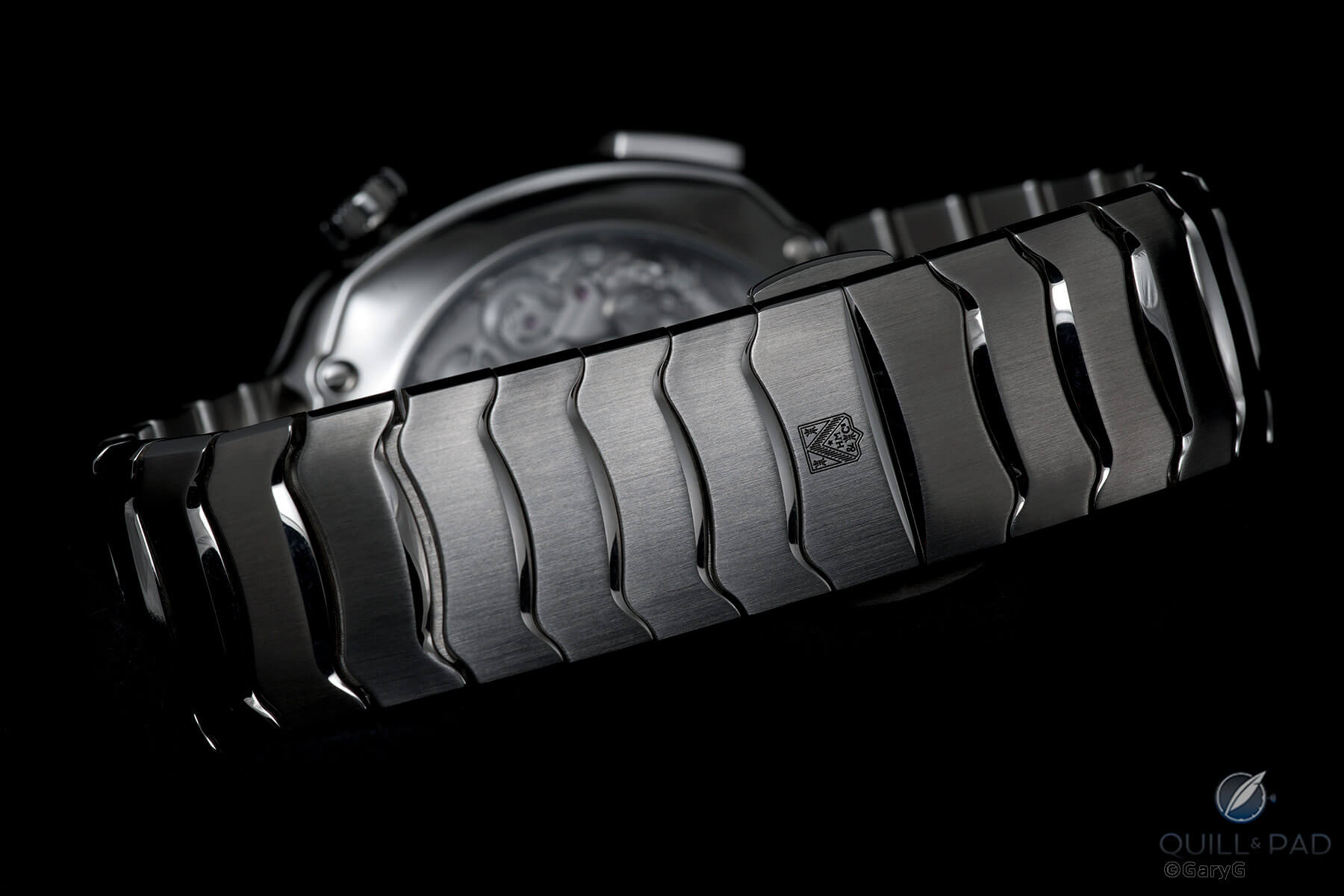
Integrated bracelet, H. Moser & Cie Streamliner Flyback Chronograph
I could quibble a bit about some features of the bracelet: in particular, the use of pins rather than screws to attach the removable links, and the absence of any adjustability in length while on the wrist.
But overall the quality is solid, the hidden clasp makes for a seamless under-wrist view. And it’s really clever how Moser manages to create the impression of a super-complex bracelet when the underside construction is made up of simple rectangular elements connected with straight pins and tubes.
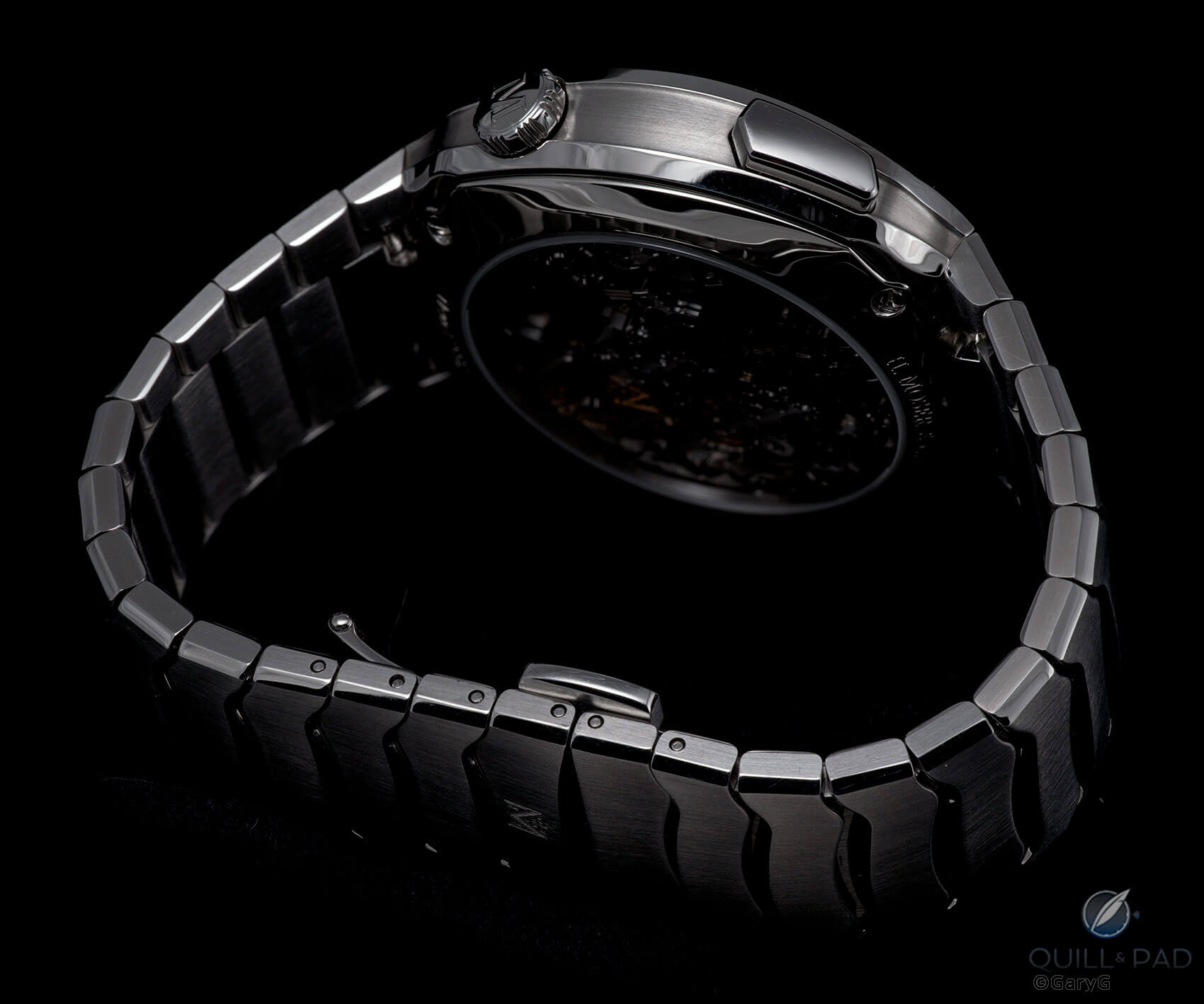
Side view, Streamliner case and integrated bracelet with hidden clasp
As for wearing, the example watch that I had for shooting was just a touch tight on my wrist, but once fastened it sat comfortably and securely, with the bracelet dropping rapidly out of view around my arm.
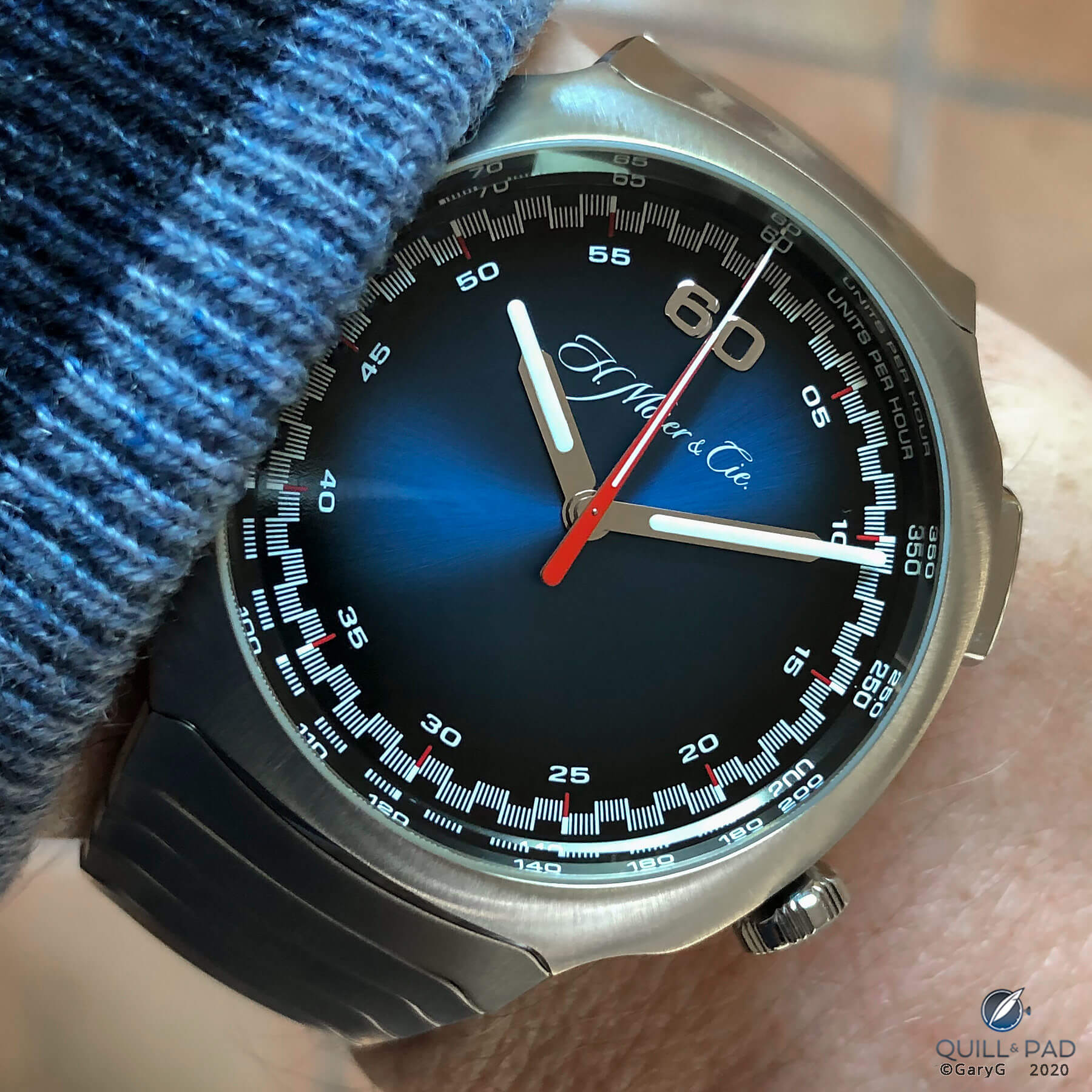
Solid fit: Streamliner on the wrist
Any other quibbles?
In the wish list department, it would be great if there were greater use of luminous materials on the dial – the ceramic-lume tips on the hour and minute hands are great, but I do wish Moser had used luminous paint for the seconds track and on the tips of the chronograph minute and second hands.
The movement finishing on the piece I handled was in the solid-not-superb category, which surprised me a bit. I’ve looked at many photos of other Streamliner chronograph movements online, and several of them looked somewhat better, so perhaps that’s just a factor of this being a prototype watch – but you should definitely check for yourself if you are considering a purchase.
And the dial showed some orange peel texture that I don’t recall from other Moser watches I’ve handled – again, production examples may differ.
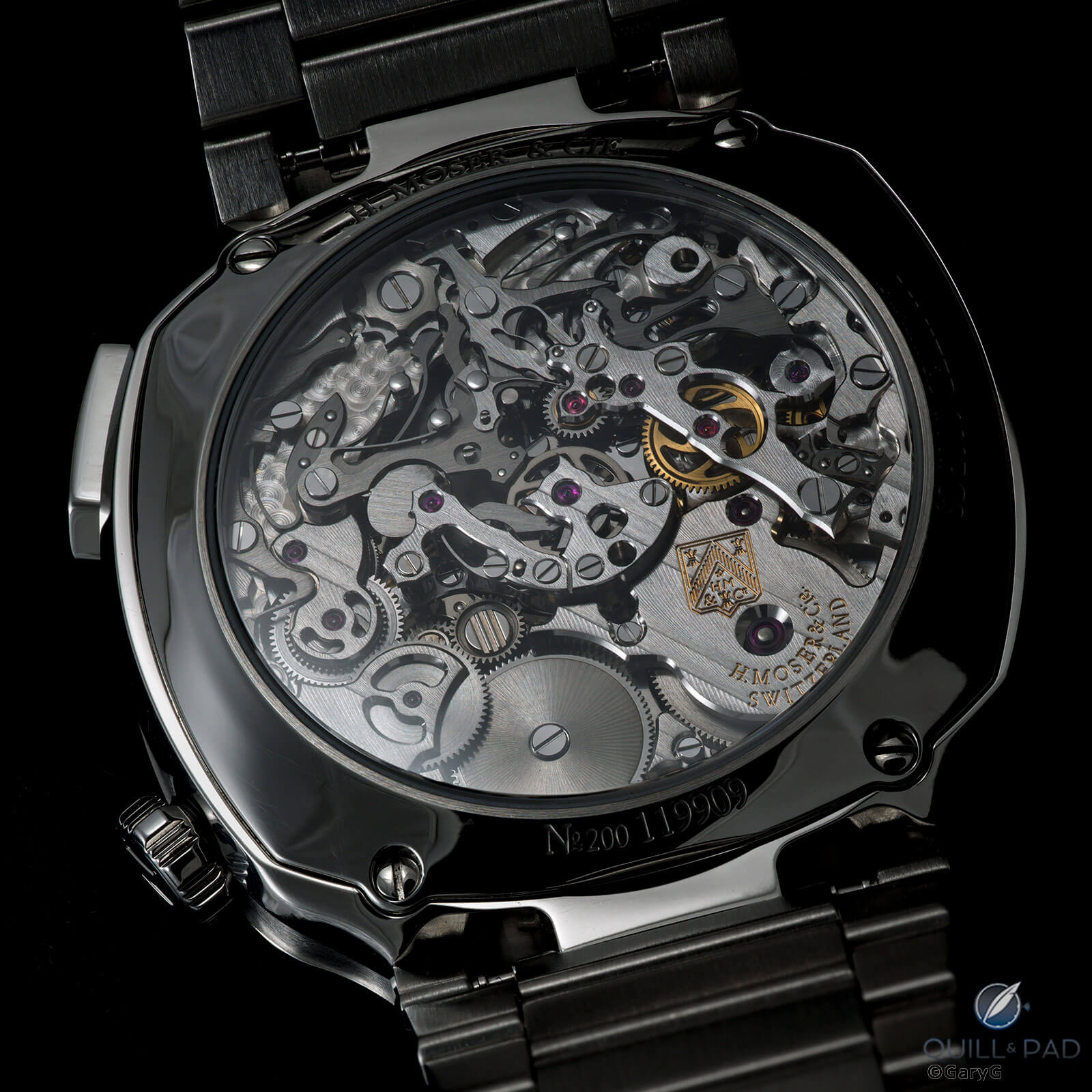
Check it out: movement finishing, H. Moser & Cie Caliber HMC 902
Is this watch right for you?
There is no perfect watch – at least not yet! I’ll confess that while the blue dial moves this piece up in its appeal to me, I still can’t warm up to the shapes of the Streamliner’s bracelet. But that doesn’t mean that you shouldn’t seriously consider it, especially if:
- The aesthetics of the Streamliner series really speak to you.
- You are keen to own an AgenGraphe-equipped watch and the cleaner dial aesthetic of the Moser embodiment is more to your taste than the AgenGraphe-based Singer and Fabergé watches.
- The additional sophistication of a flyback chronograph sets this piece above the other AgenGraphes for you.
- You are one of the growing group of Moser enthusiasts who are drawn to the brand’s combination of design minimalism and elegance.
On the latter point: I think that with watches like the Streamliner, Édouard Meylan and his team are doing a really good job with the very difficult task of migrating Moser from the “look at me” stunt-oriented identity of its original attention-getting efforts in the Meylan era to being a sustainable (in both senses of the word) enterprise.
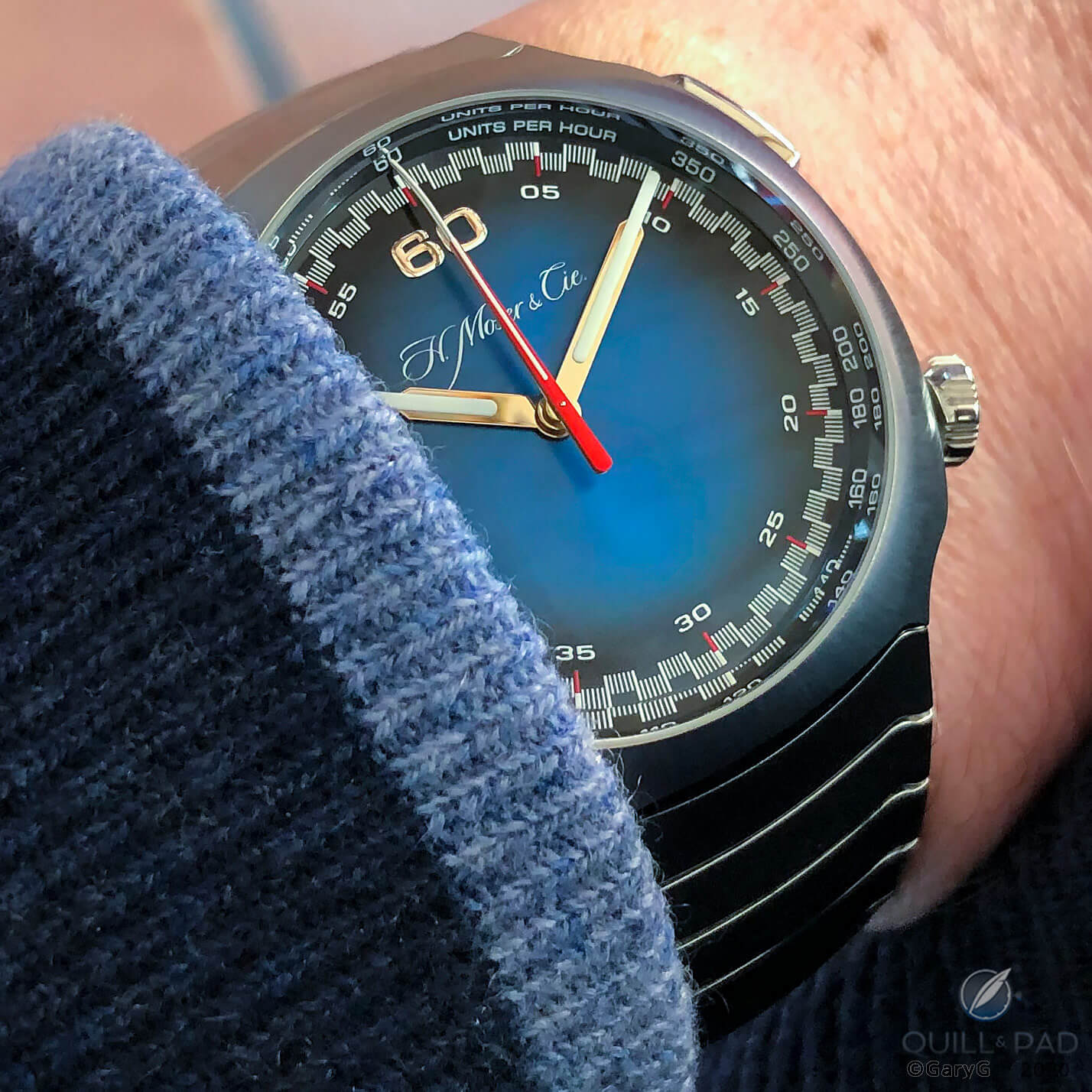
From my wrist to yours? H. Moser & Cie. Streamliner Flyback
On the other hand, you might save your $43,900 for another opportunity if:
- You suspect that when the time comes to pick a watch out of the safe for the day, you’ll almost always be tempted to make a more traditional-looking choice.
- You take a careful look through the loupe at a production-version movement of the Streamliner and find that the finishing is not quite to your tastes.
- You already have enough (or too many) blue-dialed, sporty pieces in your collection.
I’ll be very interested to hear your thoughts, including those from hard-core Moser enthusiasts and owners, in the comments below. In the meantime, happy hunting and happy wearing!
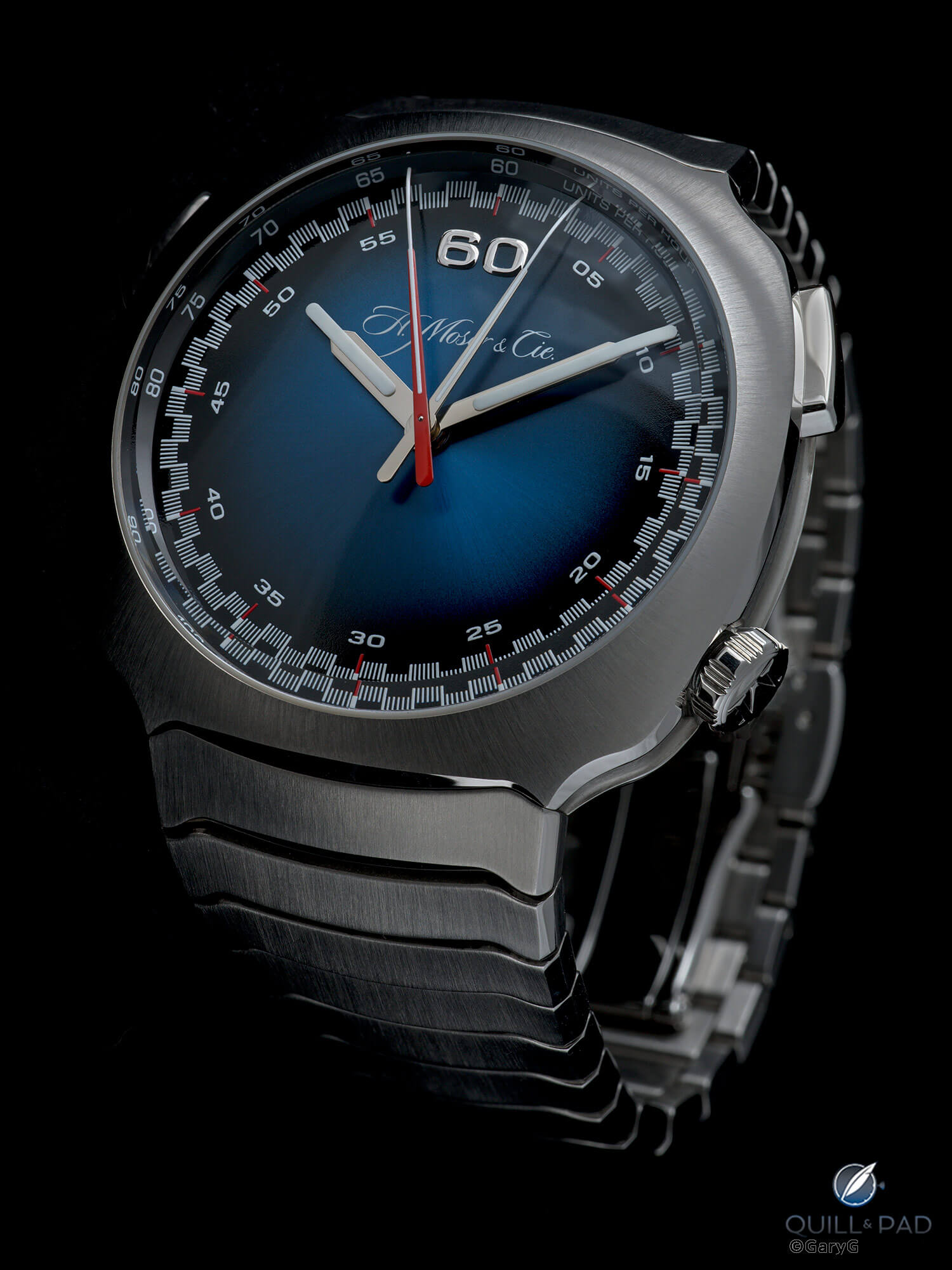
Parting shot: H. Moser & Cie. Streamliner Flyback Chronograph
For more information, please visit www.h-moser.com/streamliner-flyback-chronograph-automatic.
Quick Facts H. Moser & Cie Streamliner Flyback Chronograph
Case: 42.3 x 14.2 mm, stainless steel with brushed front bezel and case band, polished rear bezel and accents; domed front crystal and exhibition back with sapphire crystal; integrated streamlined steel bracelet with hidden clasp; shaped polished chronograph pushers; water resistance 12 ATM
Dial and hands: funky blue fumé dial with radial brushing; printed numerals, logo, and minutes/seconds and tachymeter indices; applied Arabic numerals at 60; hour and minute hands tipped with luminous ceramic; red chronograph seconds hand and silver chronograph minutes hand with white accents
Movement: automatic Caliber HMC 902 chronograph movement developed with Agenhor (AgenGraphe base); power reserve 54 hours; 21,600 vph/3 Hz frequency
Functions: hours, minutes; chronograph minutes and seconds; instantaneously jumping 60-minute chronograph
Price: $43,900
You may also enjoy:
Moser & Cie. Streamliner Flyback Chronograph Automatic With Full Metal Bracelet: Inspiring Amnemori!
Leave a Reply
Want to join the discussion?Feel free to contribute!



Dear Gary, many thanks for the as usual awesome article. I did look at the photos of the grey version as well as at the green time only piece and even though I admire the innovative effort from the Moser team in the crowded sports watch space something stops me from pulling the trigger.
One of my concern is if that design will pass the test of time or become just another strange watch from the past? Would be interesting to hear your thoughts on that?
Could you please also elaborate a bit more on the finishing details that you find to be less than perfect?
I too believe time may not be kind to this design. I’m not sure why but the overall look reminds me of the Glashutte Seventies.
But one thing that surprised me was learning the bracelet was made with pins and collars. Personally I have no issue with it though even the thin 15202 bracelet is made with screws. Grand Seiko uses pins on their titanium watches for durability issues. Wonder why Moser did.
Sorry for the delay but glad you enjoyed the article! My personal instinct is that this design is a bit unlikely to stand the test of time but I’ve been wrong on these things before so take it for what it’s worth.
On this particular example, some of the edges of the bridges had an unfinished look — quite unlike other photos I’ve seen — which was the source of my remark on finishing.
Best, Gary
An OK watch…if you can’t have a Rolex